- Home
- Gary Vaynerchuk
Crushing It! EPB Page 12
Crushing It! EPB Read online
Page 12
I was starting to despair, and then fifteen minutes later, I got a notification of payment received for $19.99 minus the fee to PayPal. It was the coolest e-mail I ever received. Then immediately after the rush, I started thinking, Crap, what if he returns it? What if he doesn’t like it? What if he sues me because the information is wrong?—all this negative stuff that most people feel when they do something outside their comfort zone. So, I go outside for a walk, because I’m hyperventilating, and I come back fifteen minutes later, and there’s another e-mail from PayPal saying that I had made a sale.
So even when I was out on a walk, I was making another sale, and that just blew my mind. Like, holy crap, this thing is now available to people 24/7/365, and I don’t have to be there in order to actually make the transaction happen. Between the book and the ads on my site, I ended up generating $7,908.55 that month, which was two-and-a-half times more than my architecture income.
There were a few ups and downs, but from that day on for the most part, Pat’s income grew month after month. He became known as a LEED expert because no one else was providing the help people were seeking. All that work he had put into the website was paying off. By March 2009, he was bringing in $25,000 to $35,000 per month.
Along with questions about the LEED exam, Pat started getting requests for information about how he had built his site and business. He remembered all the business gurus he’d looked up, the sites he’d explored, and the newsletters he’d subscribed to when he was trying to figure out how to get started himself. He recalled how he’d felt that they were doing a bait and switch, luring him in with big promises but ultimately delivering very little useful information. “I wanted somebody to be up front and honest with me, but I felt that they just wanted my money.”
So he launched SmartPassiveIncome.com, a site where he could document everything he had learned about starting an online business.
Two things happened that made him realize that these websites were not destined to be temporary income generators to keep him afloat until he could get his architecture career back on track.
The first thing was a phone call. About two months after Pat launched SmartPassiveIncome.com, his old boss got in touch. He had been let go from the prominent architecture firm as well and had started his own company. He’d invited a number of Pat’s old colleagues to join him, and he wanted Pat to come work for him, too. He offered a higher salary than Pat had been earning at the old firm, a private office, and a year’s rent. All Pat had to do was move back to Irvine and pick up where he left off. “It didn’t take me more than two or three seconds to say, ‘No, thank you.’ And when I hung up, I thought about his offer and was very surprised that I had answered so quickly. Why? It was a sign that this was the direction I wanted to go, and I needed to really own it. I wanted to become an entrepreneur.”
The second thing was that he discovered Crush It!, which helped him come to terms with what had to happen next. “The book says, ‘If you want to make money selling worms, do it, and own it, and be that guy.’ The LEED exam stuff? Those were my worms. I was that guy.”
It wasn’t just reading the text of Crush It! that influenced how Pat ran his business. Visiting the book’s Amazon page, Pat noticed something else.
Gary was actually replying to the occasional negative reviewer and saying, “Hey, I’m sorry this book didn’t speak to you. Let’s get on the phone and chat.” I couldn’t believe that an author was paying attention, responding to comments, and offering a phone or Skype number. Many of the one- or two-star reviewers came back with a follow-up comment. They might not have changed their opinion, but they’d say, “Gary, I still don’t agree with you, but I so appreciate the time you took to reach out to me and understand where I was coming from.” That impressed me more than even the content of the book itself. Where is the ROI in responding to a one-star comment? I saw that (a) he took the time, (b) he cared enough to reach out, and (c) he cared to see what he could do to improve.
After that, Pat adopted the same response strategy to any negative comments he received, and the ROI has been clear. “Sometimes those people with whom I’ve talked on calls just misunderstood something I said and have gone on to become some of my biggest fans.”
Right around this time, Pat’s earnings show a striking upward inflection point. “I’m not saying that Crush It! was the sole reason why I was able to grow my income to what it is now, but I went bigger, that’s for sure. I started to produce more things instead of being just a blogger. I started to look for other ways to expand beyond my realm of comfort.”
And expand he did. He started a YouTube channel in 2009. In 2010, he launched the Smart Passive Income podcast, which has seen more than forty million downloads. In 2011, he started accepting offers to speak. To provide a space to answer the deluge of questions he gets from his followers, he then created a daily Ask Pat podcast, as well as a few others to address niche subjects. His self-published book was a Wall Street Journal best seller.
All along, he followed through on his commitment of being a “crash test dummy” for online business development. He started creating new businesses live in front of people—like a site for people interested in starting food trucks and one for people interested in becoming security guards—and posting his revenue for those, too. If he made a mistake, he made it in public. He detailed every step of the process along the way. In the end, Pat’s passion for architecture and design was surpassed by his passion for helping others.
I’m getting e-mails from people, paragraphs long, thanking me for helping them save time and effort or for helping them get a promotion. I’ve gotten handwritten letters from people I’ve helped pass the exam. The interesting thing is that in October 2009, I asked people why they had bought the e-book from me. I thought the information would be useful so I could continue to do whatever it was they were going to tell me was working. About a quarter of those who responded said things like, “Pat”—that was another cool thing; they were calling me by name, as if they knew me—“Pat, I bought from you because you finally gave me an opportunity to pay you back. I didn’t even need the book; I’ve already passed the exam. But you provided me so much information, I felt I needed a way to give back to you.” I eventually learned that this reciprocity is human nature, and I was setting up systems for that kind of interaction and transaction.
The great thing about Pat’s success is how many options it affords him. He has been expanding his philanthropic reach, and he serves on the board of an educational nonprofit. He’s interested in getting involved in shaping education policy. Despite his belief in Crush It!, he isn’t trying to be another GaryVee. “I am who I am and he is who he is. That’s what Crush It! is also about, you know: being confident in who you are, not trying to be like somebody else. When you really own it, and you put yourself out there and be you, your vibe is going to attract your tribe, and you’re going to be able to make change in this world.”
Pat’s story is waiting to be told a thousand more times. I know many of you have niche expertise, yet you don’t think it could possibly be a real business. But come on! I mean, the LEED exam? Are you kidding me? If Pat Flynn can make a stellar income off a website dedicated to helping people pass an exam only a few people in the country have ever heard of, you can do it with soccer trivia or smoothies. Please dig deep into what you know best or what you love most, or better yet, what you know best and love most, and start creating content. Follow the blueprint Pat’s story provides; go deep, go niche, and provide real value in the form of entertainment or information.
Though it may seem that, over the years, influencers have had their pick of thousands of platforms they could use to establish their brands, you need only both hands and a few toes to count the number that actually had the ability to grow big enough to scale. It’s really, really hard for a platform to earn a spot in this book. If I’ve included it, it’s because it’s grown into such a beast, it cannot be ignored, or because I see the potential for it to become
that kind of beast. When considering where to build your personal brand, you want to use nothing less than platforms upon which you can actually build your life. Every platform we discuss in the following chapters fits that description.
II
Create Your Pillar
6
First, Do This
No matter what kind of influencer you want to become, everyone must start with this step: create a Facebook business page.
Facebook is the cost of entry to building a personal brand. Do not try to tell me that you don’t have to do it because you’re targeting the twenty-two-and-unders, who are not on Facebook in the same numbers as older groups. As you’ll see, the strides Facebook is making in video make it likely that it’s about to become more appealing to those young viewers. You want to be waiting for them when they start opening Facebook accounts. Facebook will get to the young demo; you can count on it. Don’t ever underestimate Mark Zuckerberg, and don’t ever bet against Facebook.
How I’m Crushing It
Costa Kapothanasis, Costa Oil—10 Minute Oil Change
IG: @costakapo
Constantine “Costa” Kapothanasis sounds like a practical man. The first-generation Greek American from Portland, Maine, won a Division 1 baseball scholarship to a college in Maryland. Forced to give up the sport professionally after a shoulder injury, he moved on to earn a master of science in finance. After graduation, he worked for several large financial companies, but nothing stuck. “I either got fired or was almost fired from every job.” He chafed against bureaucracy. Not only did these large firms force him to follow strict, cumbersome protocols that to him seemed inefficient and counterproductive, but also their restrictive social-media policies hampered his side business of making custom, hand-carved baseball bats. Bank trading hours were 9:30 a.m. to 4:00 p.m., and Costa found himself missing opportunities because he couldn’t respond right away to potential customers on Twitter, which was enjoying its heyday. It didn’t help that, as the years went on, friends from his baseball days made it to the majors and were making millions playing the game they loved, while he was sitting in a cubicle. Many years went by in which he avoided watching baseball on television.
He needed to plan an escape, so while still working for the financial firm, he sold the assets to the baseball bat business and bought a quick-lube, a place where you take your car for a fast oil change. It wasn’t the most glamorous or exciting business, but he saw it as an investment in a “quasi-utility,” almost like electricity or water: in a car-dependent country with few mass transit options, most Americans will eventually need an oil change. Then, as was almost inevitable, he got fired. It was fantastic! “Getting fired was this amazing thing for me. My quality of life went through the roof. I never realized how much of a weight was on me, and now it was gone, and it put me into high gear to do something with the business.”
Costa went all in on his quick-lube company, which he named Quick Change Oil, but his strategies weren’t all that effective. Direct mail. Search-engine optimization. An iHeartRadio commercial that was before its time. He wasted a lot of money. He found himself about eight months later alone in the store on New Year’s Day, 2016, because he had given his employees the day off. Sales were not great, and he was in a tough spot. Nothing was going on, so he was reading a book called Crush It! The more he read, the more he thought, Man, I need to do this.
No more direct mail, no more SEO, no more commercials. Instead, he took to YouTube, and in between cars and after work until two a.m., he taught himself about Facebook ads. “I didn’t want to storytell incorrectly. I didn’t want to miss an opportunity.”
By February, 100 percent of his marketing budget was devoted to Facebook ads, and he was immersed in social engagement and creating content. He used Twitter searches to find any vehicle-related conversations that would give him a chance to talk to people. From Chevy Cobalts to Porsches, he photographed his customers’ cars for Instagram, tricking the images out with photo filters to make them look snazzy and sharp (customers like seeing their cars online so much, he doesn’t have to ask them for permission anymore—they ask him to do it first). He started putting out educational videos to help inform potential customers about the ins and outs of their cars. “We have put out videos on the different types of oils, the difference between a full-synthetic and a conventional, on when you should do an engine flush. And we’ve gotten lots of feedback. People will type messages like, ‘This is the first time anyone has actually explained to me what the purpose of my air filter is.’ I truly believe that the most educated customer will always pick us.”
Less than a year after that New Year’s Day when he sat in his empty shop wondering how he was going to jump-start his business, he had six store locations and was under contract for two more, spread out over several states. Today he’s busy running the business, keeping his social-media engagement up and staying genuine, creating content, and appearing on various financial TV and radio shows to talk about his journey. He was even invited to speak at a university entrepreneurship program. He and his wife are talking about starting a family. He’s been working on building his personal brand, too—in 2017, all the businesses were renamed Costa Oil—10 Minute Oil Change.
7
Get Discovered
You need to understand something: when you’re starting with nothing, you will find that your absolute breakthrough opportunities will be developed in two ways:
By the smart use of hashtags, a strategy that requires an unbelievably long grind.
By direct-messaging, i.e., reaching out directly to people and offering something of value in return for their attention, a strategy that requires an unbelievably long grind.
It’s the second one that I believe holds the most promise, which is why, whenever possible, I’ve included instructions on how to collaborate and business-develop within each platform we discuss in this book. Collaborations are the absolutely most tried-and-true way to grow a fan base quickly—quickly being a relative term. In most cases, you should count on this process taking years, not months. If that bothers you, close the book.
Many are uncomfortable with the idea of direct-messaging total strangers, but let me help you think about these total strangers another way. Let’s say a friend invites you to join a group for dinner at a restaurant, and she also brings a couple you don’t know. You wind up sitting next to each other and have a great time. You’re an interior designer, and you find out that this couple is in the beginning stages of deciding to redo their home. Do you hide the fact that you’re an interior designer? Of course not. It’s natural to tell them what you do for a living, and that’s going to become part of your conversation because you just discovered a mutual interest. Now, at the end of the evening, would it be weird to hand them your card and say, “Check out my website, maybe we can work together. Or let me know if you need other recommendations.” Of course not. You have a mutual interest, they need a service, you can provide that service. It follows that you should give them the opportunity to decide if you would be a good fit.
Online, social-media platforms are the mutual friends connecting you to millions of people that share your interest in interior design. Your job is to do the research and find out which would find the most value in your offer and then make your case. I’ll share with you the specific details on how to do this in upcoming chapters, but the general process is essentially the same on each platform: reach out, make an offer they can’t refuse, and get to work producing something that doesn’t make them regret giving you a chance.
Now, there’s something you should know: right this minute I have around five hundred DMs from people who want something from me. You know what I have to say to them? Mazel tov, and go away. And that’s if I’m in the mood to be nice.
Why would I encourage you to try to get other influencers’ attention when I ignore or reject the majority of people who try this tactic with me? Because if they were doing it right, I wouldn’t reject them. If I felt they were
n’t just trying to use me, if I thought they were genuinely trying to be helpful, if they could recognize a hole in my business and had the knowledge and skills to fill it, I might consider talking to them.
When you can’t offer exposure or money, what do you have? Knowledge and skill. Do you own a pizza shop? You could offer free pizza from your shop for six months. Are you a graphic designer? You could offer to make six hundred custom filters. Do you own a liquor store? As soon as your targets post shots of themselves enjoying wine, you could direct-message them with an offer for a case a month for the rest of the year (if your state laws allow that—New Jersey doesn’t ☹). People will tell you not to sell yourself cheap, but you can stand on that principle only when people are willing to buy what you’re selling. (For a perfect example of how to do this right, read DRock’s story in chapter 3 of my book #AskGaryVee, or you can hear his version of the story in his Medium piece, “How I Got My Job for Gary Vaynerchuk.”)*
If established influencers see an upside to collaborating with you—allowing you to post content on their pages, working together to create content—they’ll get back in touch. If not, they’ll say no thanks, usually by not answering. But if you reach out for six or seven hours a day, you will eventually find someone willing to try something new with you. Once you do, you’ll have raised awareness with thousands of people who previously didn’t know you were alive. Provide something valuable to your collab partner, and you’ll quickly raise your profile as an influencer and in all likelihood make a new friend.
I won’t lie. Biz-deving this way is hard, tedious, and time-consuming. I like tedious. It means most people won’t do it. If you do, you will win. If you’ve got the money to run ads on all these platforms or pay influencers to feature your product, more power to you. But if you’re just starting out and have no money, this is the number-one thing you can do to build your brand.

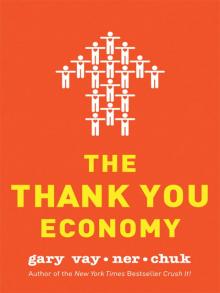 The Thank You Economy
The Thank You Economy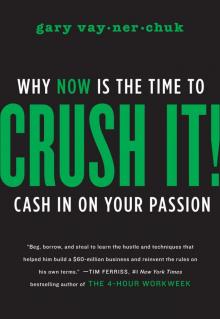 Crush It!
Crush It!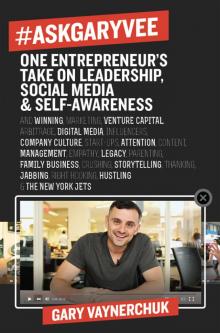 #AskGaryVee
#AskGaryVee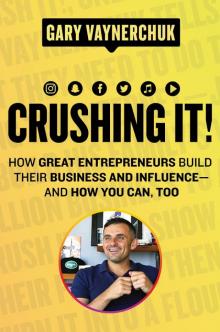 Crushing It! EPB
Crushing It! EPB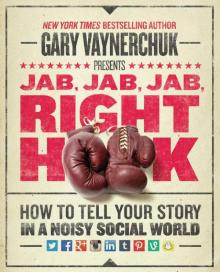 Jab, Jab, Jab, Right Hook
Jab, Jab, Jab, Right Hook